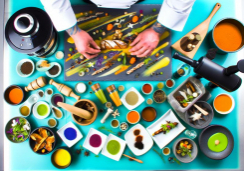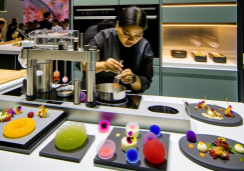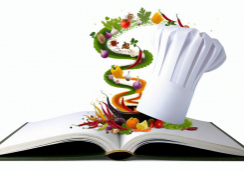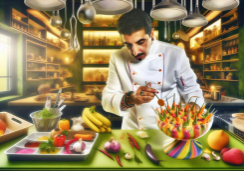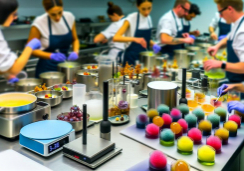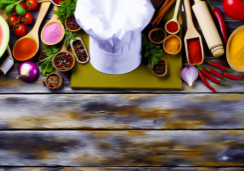9 Culinary Tricks to Elevate Your Recipes
As you stand in your kitchen, the culinary equivalent of an alchemist's lab, you're about to transform simple ingredients into gold with a pinch of know-how and a dash of creativity. You've likely mastered the basics of boiling an egg or toasting bread, but there's a plethora of tricks that can elevate your dishes from the mundane to the sublime.
Sharpen your knives and your senses; it's not just about following a recipe to the letter, but understanding the subtle nuances that can make all the difference. Whether it's knowing when to add a splash of acidity or how to properly sear a steak to lock in juiciness, these nine tricks are the keys to unlocking a treasure trove of flavors.
So, don your apron and prepare to discover how a few simple adjustments can transform your culinary creations, and perhaps, find out what the ninth secret is that chefs swear by but seldom share.
Master Knife Skills
Sharpening your knife skills not only speeds up your prep work but also ensures uniform cooking and presentation of your dishes. You'll find that a trusty chef's knife becomes your best ally in the kitchen once you've mastered the basics. The key is to hold the knife firmly yet comfortably, with your thumb and forefinger gripping the base of the blade for control. Your other fingers should wrap around the handle, securing it.
Start with the rocking motion technique, where the tip of the chef's knife stays in contact with the cutting board, and you rock the blade up and down. This method is perfect for mincing herbs or garlic.
Transitioning to chopping, make sure your fingers are tucked safely, using your knuckles as a guide for the knife—this keeps your fingertips out of harm's way.
Balance Flavor Profiles
As you blend the basic tastes of sweet, salty, sour, bitter, and umami, you'll discover the art of creating a well-balanced dish.
It's all about finding the right harmony between contrasting flavors to give your recipes a complex, memorable edge.
Adjust your seasoning techniques with precision to fine-tune the balance, ensuring each bite is a testament to your culinary prowess.
Understanding Taste Elements
Mastering the delicate dance of sweet, salty, sour, bitter, and umami can transform your cooking, turning simple ingredients into complex, mouth-watering dishes. To achieve this, you'll need to identify and balance these basic taste elements.
Consider the bright zing of fresh basil—it can introduce a peppery yet sweet note that complements a dish's profile.
Pay close attention to how each taste impacts your palate. A pinch of salt might enhance sweetness, while a dash of lemon juice can cut through richness.
Experiment with different ingredients and cooking techniques to either highlight or subdue certain flavors.
Achieving Flavor Harmony
To craft a culinary masterpiece, you'll need to artfully balance the savory, sweet, acidic, salty, and spicy elements, ensuring no single flavor overwhelms the dish. Imagine the delight when each taste complements the others, making your creation taste better with every bite.
If a dish is too spicy, a hint of sweetness can soften the heat. Similarly, a squeeze of lemon adds a bright acidic note to cut through rich, savory flavors, achieving a satisfying depth.
As you cook, consider what to add to round out predominant tastes. Remember, an excess of salt or spice can hijack the palate. Strive for that harmonious blend, where all flavors sing in unison, and you'll turn a simple meal into an exquisite taste experience.
Adjusting Seasoning Techniques
Building on the foundation of flavor harmony, refining your seasoning techniques is key to elevating even the simplest of dishes. You've got to taste your dish at different stages, adjusting seasoning to nail that balanced, flavorful profile.
Get creative with spices, herbs, and a dash of acidity to find the perfect symphony of flavors. Remember, salt's your friend to amplify taste, but it's a fine line—don't overdo it. For a zesty kick that cuts through richness, a splash of vinegar or a squeeze of lemon juice can work wonders.
Keep tasting and tweaking; that's the secret sauce to the ultimate flavor. And don't forget a drizzle of olive oil for a smooth finish that can really make your dish sing.
Utilize Fresh Herbs
Infuse your dishes with the vibrant and aromatic flavors of fresh herbs to instantly elevate their complexity and appeal. Fresh parsley, basil, cilantro, thyme, tarragon, or chives aren't just garnishes—they're game-changers. These lively greens can transform the mundane into the sublime with just a few snips.
You'll want to keep a variety of fresh herbs in the fridge, prepped and ready to go. Imagine the burst of freshness when you sprinkle basil over a steaming plate of pasta just as you finish cooking, or the zest that cilantro adds to a perfectly seasoned taco.
Unlike their dried counterparts, fresh herbs maintain an essential oil-rich zest that dried herbs often lose.
Perfect Your Searing Technique
Mastering the art of searing can turn a simple piece of meat into a mouthwatering centerpiece, boasting a caramelized crust that's rich in flavor and texture.
To begin, grab your stainless steel pan and preheat it over medium-high heat. This crucial step ensures your meat won't just steam in its own juices – it's the bedrock of a proper sear.
Make sure your meat is patted dry before it hits the pan. Any excess moisture is a barrier to achieving that sought-after golden-brown crust.
Now, pour in a high smoke point oil like refined avocado or grapeseed. These oils can take the heat without burning, which is essential when you're cranking up the temperature.
Experiment With Textures
After perfecting your sear, take your culinary creations to the next level by experimenting with a symphony of textures that will tantalize the palate. The right combination of crunch, creaminess, and contrast can elevate even the simplest dish into a memorable meal.
Picture yourself in the kitchen, a cutting board laden with an array of ingredients, each poised to add a unique textural element to your dish.
Here are a few ways to introduce texture into your cooking:
- Roast or fry vegetables to bring out a delightful crispness that contrasts beautifully with tender meats.
- Toss in nuts, seeds, or croutons for that satisfying crunch, transforming salads and soups from mundane to extraordinary.
- Swirl in a creamy sauce, a luxurious puree, or a dollop of whipped topping to balance crunchy textures with a velvety smooth finish.
- Play with temperature contrasts by pairing a warm, hearty stew with a cool, crisp garnish for an experience that's as intriguing as it's delicious.
Make Homemade Stock
Creating your own homemade stock can be a game-changer in the kitchen, acting as a robust foundation for your culinary creations.
You'll notice the nuanced differences between stock and broth as you explore how each can uniquely influence the depth of flavor in your dishes.
Keep your pantry stocked with your homemade versions, and you'll have a secret weapon for enriching soups, stews, and sauces with a personal touch.
Flavor Foundation Essentials
Dive into the world of culinary foundations by learning to craft your own homemade stock, a simple step that'll imbue your dishes with unmatched depth and flavor. When your recipes taste better, it's often thanks to a robust, aromatic stock.
Here's what you need to get started:
- Blanch chicken bones to extract maximum flavor
- Combine herbs for a fragrant bouquet
- Chop carrots and celery for a sweet, earthy base
- Add onions to round out the mirepoix
This savory elixir not only makes your soups and sauces standout, but it also transforms the mundane into the magnificent. Plus, it's a smart way to utilize leftover ingredients.
Keep this flavor foundation on hand, and you'll elevate your cooking to new heights with every spoonful.
Stock Versus Broth Differences
Understanding the differences between stock and broth can significantly enhance your culinary creations, as each brings its own unique set of flavors and uses to the kitchen.
Stock, a rich base crafted from simmering bones and vegetables, is your secret weapon for dishes that demand depth, like risotto or ratatouille. Dive into the cooking process with blanched chicken bones, aromatic herbs, carrots, celery, and onion, and let these ingredients meld over a low flame. The patience pays off; the bones release gelatin and flavors slowly, giving you a complex liquid that's miles ahead of any store-bought broth.
You can refrigerate or freeze it, ensuring that you've got the perfect foundation ready for your next braising adventure or for glazing carrots to perfection.
Embrace Global Spices
Have you ever wondered how a pinch of garam masala or a sprinkle of sumac could transform your cooking? By embracing the world of global spices, you're not just adding flavor, you're embarking on a culinary adventure that'll make your dishes stand out.
Here's how to dive in:
- Explore a variety of global spices to add depth and complexity to your dishes.
- Experiment with spices like cumin, turmeric, garam masala, and sumac for diverse flavor profiles.
- Research traditional spice blends from different cultures to create authentic international dishes.
- Combine global spices with your favorite recipes to give them a unique and exotic twist.
Global spices aren't just ingredients; they're the essence of centuries-old culinary traditions from around the world. They can transform the mundane into the extraordinary. Whether you're looking to replicate the vibrant markets of Marrakech with a teaspoon of cumin or bring the warmth of an Indian kitchen to your home with garam masala, these spices are your ticket.
Don't be afraid to mix and match, and let your palate guide you. With global spices, your kitchen becomes a nexus of world flavors, and your recipes, a passport to international taste sensations.
How Can Culinary Tricks Elevate the Healthiness of Vegan Recipes?
Incorporating healthy cooking techniques can enhance the vegan recipe health benefits. Using natural sweeteners like dates or maple syrup can cut down on refined sugar. Adding herbs and spices like turmeric, garlic, and ginger not only boosts flavor but also offers anti-inflammatory properties. Grilling or roasting vegetables can enrich the nutritional value of dishes.
Enhance With Acidity
Often overlooked, the clever addition of acidity can elevate your dish from good to extraordinary by cutting through richness and adding a burst of brightness. When your recipes taste flat or too heavy, a splash of vinegar or a squeeze of lemon juice can make flavors pop and your taste buds dance. The sharp tang of acidity acts as a culinary counterbalance, harmonizing with savory and earthy elements to create a well-rounded taste that's simply unforgettable.
Think of acidity as the secret ingredient that brings everything together, enhancing the existing flavors and making your dish taste better. It's not just about adding a sour note; it's about depth and contrast. Whether you're simmering a stew or dressing a salad, the right amount of acidity can transform your cooking into an art form.
Remember to match the type of acidity to your dish's flavor profile. Will a sharp balsamic vinegar complement your roasted vegetables, or does a citrusy lime better suit your grilled fish? Experiment and taste as you go—your palate will guide you to the perfect acidic touch that takes your culinary creations from simply satisfying to truly exceptional.
Practice Plating Aesthetics
While mastering the balance of flavors is crucial, don't forget that the visual appeal of your dish also plays a significant role in the overall dining experience. It's not just about taste when it comes to impressing your guests or elevating your home cooking; the presentation of your dish can make a memorable impact.
Here are a few tips to enhance your plating aesthetics:
- Consider the use of negative space to allow your dish to stand out.
- Use contrasting colors and textures to create visual interest on the plate.
- Pay attention to the balance of the elements on the plate for an aesthetically pleasing arrangement.
- Utilize garnishes like fresh herbs or edible flowers to add a pop of color and elevate the presentation.
When plating baked goods, the contrast between a dark chocolate cake and a dusting of powdered sugar can be visually striking. The same goes for a vibrant berry compote drizzled over a golden-brown cheesecake. Remember to experiment with different plate shapes and sizes to find the perfect canvas for your culinary creations.
With practice, your plates won't only taste delicious but will also turn into edible art that's almost too pretty to eat.
Conclusion
Now that you've got the insider tips, step up your culinary game. Hone those knife skills for uniform, impressive cuts. Balance flavors like a pro, and don't forget the magic of fresh herbs.
Sear to perfection, play with textures, and craft your own stock. Dive into global spices, brighten with a splash of acidity, and present your plates with flair.
Embrace these tricks, keep experimenting, and watch your dishes transform from good to unforgettable.
Bon appétit!

